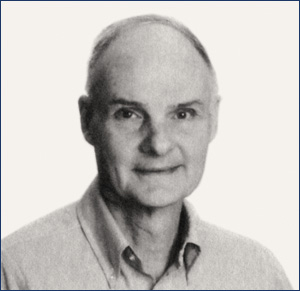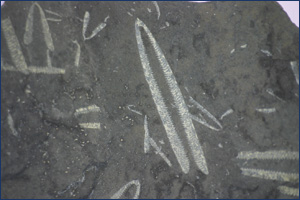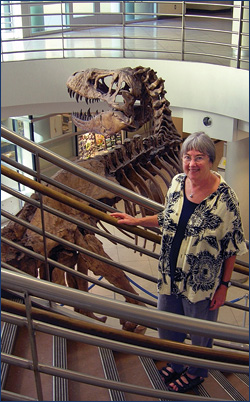
Seven recollections of paleontologist Bill Berry
by Carole Hickman, Curator and Professor Emeritus, UC Museum of Paleontology
 |
| William B.N. (Bill) Berry |
Museums and stratigraphy
UCMP has always served as a major archive of stratigraphic data. Our fossils are arranged by time units and rock units, not by their taxonomy and classification. Nowhere in our collections is the stratigraphic archive more thoroughly preserved and creatively used than in Bill Berry's research on Ordovician and Silurian graptolites. Bill and I taught a course in stratigraphic paleontology in the 1980s when he was using the succession of ecological assemblages of graptolites to develop the new concept of "ecostratigraphy." I was probably more excited about this than were the students in the course. This excitement was compounded when Bill began his remarkable collaboration with Pat Wilde and Mary Quinby-Hunt to develop the tools to document and interpret variation in the chemistry ("chemostratigraphy") of his graptolite-bearing black shale sequences. The formal rules of stratigraphy are more complicated than the rules of biological nomenclature, and Bill's contributions to stratigraphy are grounded in a long tradition at UCMP.
Bill's own philosophy and methodological approaches to age determination and correlation were deeply influenced by the late Robert Kleinpell. I never met Kleinpell, but I inherited his office in the Earth Sciences Building. I sometimes felt haunted by the knowledge that Bill regarded him as a god-like figure who integrated biology and geology in zonation of Tertiary rocks of the West Coast and their importance in petroleum exploration. One of Bill's last major publications was a contribution to history of science entitled Robert M. Kleinpell: Founder of the Berkeley School of Stratigraphic Paleontology.
 |
| A slab bearing fossils of Bill Berry's beloved graptolites. |
Museums and the public
Although public Museums have a clear mandate to educate and interact with the public, the primary educational role of the academic natural history museum has been in supporting undergraduate and graduate instruction. Bill saw the need of great museums in the public university to connect with the public. Before the institution of "Cal Day" as a campus-wide event, Bill initiated a yearly open house in the Museum of Paleontology. It was an immense success and became an especially popular event for families with children who had no idea what went on "behind the scenes" in a museum. Kids who had never before touched a fossil got to touch lots of stuff, including live relatives (from starfish to snakes). We identified fossils and answered questions, not only at open houses, but whenever visitors brought specimens in. One tangible reward was the donation of specimens and a group known as the "Friends of Fossils" that helped raise awareness of the importance of recording data to go along with their specimens.
 |
| Carole Hickman and friend. |
Museums and the training of graduate students
All of us in UCMP believe that field research, the collection of fossils, and the growth of systematic collections are important in mentoring new generations of paleontologists. Bill was especially generous in his mentoring of students and exemplary in his disinclination to hand students dissertation topics or insist that they work on graptolites or in Ordovician or Silurian rocks. He was not out to clone himself. His students worked in all parts of the geologic column, and they worked a great variety of fossil marine organisms. They developed what I like to call a "museum consciousness," and they left Berkeley equipped for positions in museums as well as credentials for jobs in academia. Four of Bill's former Ph.D. students recall Bill's mentoring in this issue of the UCMP News.
Museums and the history of paleontology
Bill was very much interested in the lives of paleontologists. In addition to his biographical publications on the UC paleontologist Robert M. Kleinpell (mentioned earlier), Bill published on the contributions of James Hutton (the father of modern geology) and Charles Darwin as a paleontologist, geologist, and biostratigrapher.
Museums and the publication of research
The mandate to publish ("publish or perish") is a well-known feature of the academic enterprise. Today this means publishing in the top peer-reviewed scientific journals with a high "impact factor." Bill joined the Berkeley faculty and UCMP in 1958, and his most recent bibliography lists 337 publications in more than 30 national and international journals. It may be surprising to younger paleontologists that 134 of his publications were abstracts. It may be even more surprising that he presented papers not only at large national and international meetings, but also at small topical conferences and field conferences. He appears to have devoted considerable effort to getting data and ideas quickly to those who were most interested. As a new recruit to the Berkeley faculty, Bill advised me on publishing: "To get tenure, you will be fine with six publications per year." I took this to mean journal articles, and it was only recently that I realized that he had a broader definition of productivity. Bill also recognized that large faunal monographs and taxonomic monographs were an expected product of field- and collection-based research and that an important monograph needed to be "weighed" accordingly by departments and deans. Indeed many important UCMP doctoral dissertations have been published over the years in the prestigious series "University of California Publications in Geological Sciences."
Bill Berry photo origin and photographer unknown; graptolites photo by Kevin Walsh (CC BY 2.0); Carole Hickman photo by Dave Smith, UCMP